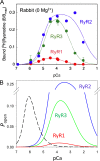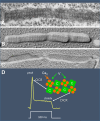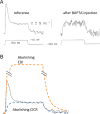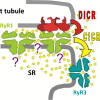Calcium-induced release of calcium in muscle: 50 years of work and the emerging consensus
- PMID: 29514865
- PMCID: PMC5881447
- DOI: 10.1085/jgp.201711959
Calcium-induced release of calcium in muscle: 50 years of work and the emerging consensus
Abstract
Ryanodine-sensitive intracellular Ca2+ channels (RyRs) open upon binding Ca2+ at cytosolic-facing sites. This results in concerted, self-reinforcing opening of RyRs clustered in specialized regions on the membranes of Ca2+ storage organelles (endoplasmic reticulum and sarcoplasmic reticulum), a process that produces Ca2+-induced Ca2+ release (CICR). The process is optimized to achieve large but brief and localized increases in cytosolic Ca2+ concentration, a feature now believed to be critical for encoding the multiplicity of signals conveyed by this ion. In this paper, I trace the path of research that led to a consensus on the physiological significance of CICR in skeletal muscle, beginning with its discovery. I focus on the approaches that were developed to quantify the contribution of CICR to the Ca2+ increase that results in contraction, as opposed to the flux activated directly by membrane depolarization (depolarization-induced Ca2+ release [DICR]). Although the emerging consensus is that CICR plays an important role alongside DICR in most taxa, its contribution in most mammalian muscles appears to be limited to embryogenesis. Finally, I survey the relevance of CICR, confirmed or plausible, to pathogenesis as well as the multiple questions about activation of release channels that remain unanswered after 50 years.
© 2018 Ríos.
Figures











Similar articles
-
A novel mechanism of tandem activation of ryanodine receptors by cytosolic and SR luminal Ca2+ during excitation-contraction coupling in atrial myocytes.J Physiol. 2017 Jun 15;595(12):3835-3845. doi: 10.1113/JP273611. Epub 2017 Feb 1. J Physiol. 2017. PMID: 28028837 Free PMC article.
-
Evolution of Excitation-Contraction Coupling.Adv Exp Med Biol. 2020;1131:281-320. doi: 10.1007/978-3-030-12457-1_12. Adv Exp Med Biol. 2020. PMID: 31646515
-
Regulation of junctional and non-junctional sarcoplasmic reticulum calcium release in excitation-contraction coupling in cat atrial myocytes.J Physiol. 2003 Jan 1;546(Pt 1):119-35. doi: 10.1113/jphysiol.2002.026963. J Physiol. 2003. PMID: 12509483 Free PMC article.
-
Roles of two ryanodine receptor isoforms coexisting in skeletal muscle.Trends Cardiovasc Med. 2002 Oct;12(7):305-11. doi: 10.1016/s1050-1738(02)00179-2. Trends Cardiovasc Med. 2002. PMID: 12458093 Review.
-
Calcium-induced calcium release in skeletal muscle.Physiol Rev. 2009 Oct;89(4):1153-76. doi: 10.1152/physrev.00040.2008. Physiol Rev. 2009. PMID: 19789379 Review.
Cited by
-
Recent Advances in Pharmacological and Non-Pharmacological Strategies of Cardioprotection.Int J Mol Sci. 2019 Aug 16;20(16):4002. doi: 10.3390/ijms20164002. Int J Mol Sci. 2019. PMID: 31426434 Free PMC article. Review.
-
Evolutionary isolation of ryanodine receptor isoform 1 for muscle-based thermogenesis in mammals.Proc Natl Acad Sci U S A. 2023 Jan 24;120(4):e2117503120. doi: 10.1073/pnas.2117503120. Epub 2023 Jan 17. Proc Natl Acad Sci U S A. 2023. PMID: 36649401 Free PMC article.
-
TRPM2 ion channels steer neutrophils towards a source of hydrogen peroxide.Sci Rep. 2021 Apr 29;11(1):9339. doi: 10.1038/s41598-021-88224-5. Sci Rep. 2021. PMID: 33927223 Free PMC article.
-
Mice with R2509C-RYR1 mutation exhibit dysfunctional Ca2+ dynamics in primary skeletal myocytes.J Gen Physiol. 2022 Nov 7;154(11):e202213136. doi: 10.1085/jgp.202213136. Epub 2022 Oct 6. J Gen Physiol. 2022. PMID: 36200983 Free PMC article.
-
On a Magical Mystery Tour with 8-Bromo-Cyclic ADP-Ribose: From All-or-None Block to Nanojunctions and the Cell-Wide Web.Molecules. 2020 Oct 16;25(20):4768. doi: 10.3390/molecules25204768. Molecules. 2020. PMID: 33081414 Free PMC article. Review.
References
-
- Airey J.A., Beck C.F., Murakami K., Tanksley S.J., Deerinck T.J., Ellisman M.H., and Sutko J.L.. 1990. Identification and localization of two triad junctional foot protein isoforms in mature avian fast twitch skeletal muscle. J. Biol. Chem. 265:14187–14194. - PubMed
Publication types
MeSH terms
Grants and funding
LinkOut - more resources
Full Text Sources
Other Literature Sources
Miscellaneous

